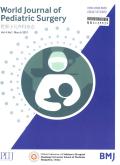Postoperative interictal epileptiform discharges predict seizure recurrence after antiepileptic drug withdrawal regardless of concordance with surgical site
IF 0.8
4区 医学
Q4 PEDIATRICS
引用次数: 0
Abstract
Objective The study aimed to explore the association between the site of interictal epileptic discharges (IEDs) on postoperative electroencephalogram (EEG) and seizure recurrence after antiepileptic drug (AED) withdrawal. The study hypothesizes that the concordance of IED sites with surgical sites indicates incomplete resection of epileptic focus, while non-concordance of IED sites with surgical sites indicates postoperative changes or cortical stimulation. The former has a higher risk of seizure recurrence. Methods We retrospectively analyzed the postoperative EEG pattern of 182 consecutive children who underwent resection surgery. To identify the risk factors for seizure recurrence, we compared the attributes of seizure recurred and seizure-free groups by univariate and multivariate analyses. AED tapering was standardized, involving a 25% reduction in the dose of a single type of AED every 2 weeks, independent of the presurgical AED load. Results We attempted AED withdrawal in 116 (63.7%) children. Twenty-eight (24.1%) children experienced seizure recurrence during or after AED withdrawal. A greater number of AEDs used at the time of surgery ( p =0.005), incomplete resection ( p =0.001), and presence of IED on postoperative EEG ( p =0.011) are predictors of seizure recurrence. The completeness of resection and seizure recurrence after AED withdrawal were related to the presence of IED on the EEG, but not to the concordance of IED with surgical sites. Conclusion For children with abnormal EEG, the decision to discontinue AED should be made more cautiously, regardless of the relative location of the discharge site and the surgical site. All data relevant to the study are included in the article or uploaded as supplementary information.术后发作间期癫痫样放电可预测停用抗癫痫药后癫痫复发,与手术部位无关
目的 该研究旨在探讨术后脑电图(EEG)上发作间期癫痫放电(IED)的部位与停用抗癫痫药物(AED)后癫痫复发之间的关联。研究假设,IED部位与手术部位一致表明癫痫灶切除不彻底,而IED部位与手术部位不一致表明术后病变或皮质刺激。前者癫痫复发的风险更高。方法 我们对连续接受切除手术的 182 名患儿的术后脑电图模式进行了回顾性分析。为了确定癫痫复发的风险因素,我们通过单变量和多变量分析比较了癫痫复发组和无癫痫组的属性。我们对 AED 的减量进行了标准化处理,包括每两周将单一类型 AED 的剂量减少 25%,与手术前的 AED 负荷无关。结果 我们尝试对116名(63.7%)患儿停用AED。28名(24.1%)患儿在停用AED期间或之后癫痫复发。手术时使用的 AED 数量越多(p =0.005)、切除不彻底(p =0.001)以及术后脑电图上出现 IED(p =0.011)是癫痫复发的预测因素。切除的完整性和停用 AED 后的癫痫复发与脑电图上是否存在 IED 有关,但与 IED 与手术部位的一致性无关。结论 对于脑电图异常的儿童,无论出院部位和手术部位的相对位置如何,都应更加谨慎地决定停用 AED。与该研究相关的所有数据均包含在文章中或作为补充信息上传。
本文章由计算机程序翻译,如有差异,请以英文原文为准。
求助全文
约1分钟内获得全文
求助全文

 求助内容:
求助内容: 应助结果提醒方式:
应助结果提醒方式:


